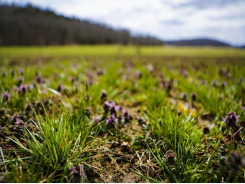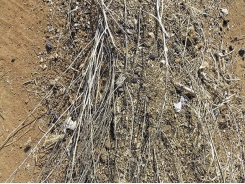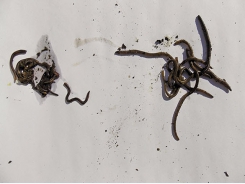Useful soil organisms

Many types of organisms affect the quality and health of our soil.
Woodlice in a mulch canopy shredding decomposing vegetation. Photo: Bill Kerr
Most farmers are unaware of their different functions and importance. They know that a high soil organism content is a good thing, but don’t realise this is only half the story. The number of organisms and their interaction with one another is also very important, as is achieving and maintaining a balance.
Simply put, regardless of the organism count in the soil, there are ‘good guys’ and ‘bad guys’. The idea is to tilt the balance in your favour through better understanding the life in your soil. So far, we’ve discussed fungi and bacteria, but these are not the only important organisms found in soil. Another group is actinomycetes, which are somewhere between bacteria and fungi.
They are very small and extremely numerous. As with the other ife-forms, some are beneficial, while others, such as the potato scab organism, cause disease. You are likely to find 2,5 million in a gram of healthy soil (up to 14 million have been recorded).
Actinomycetes comprise about 40% of the mass of soil organisms.
Interestingly, the numbers are twice as high in undisturbed soil as in cultivated soil, further proof of the benefits of no-till or minimum-till. It is a common practice to take a handful of soil and smell it when checking its condition. The clean, earthy smell we associate with a good soil is due to actinomycete activity.
Actinomycetes are also active in compost. The white strands that are sometimes visible, especially when the compost has not been turned for some time, are actinomycetes. There is usually a high concentration at the moist interface of an organic mulch and the soil as they are good at breaking down cellulose as well.
Soil ‘crabs’
Moving from microscopic to higher level organisms, earthworms are not the only creatures that play a beneficial role in the soil. Wood lice, for example, may occur in high numbers on occasion. Although they have six legs, they are not insects but crustaceans, making them closer to crabs and crayfish than say, beetles.
They live under a canopy of mulch and consume dead vegetation and other organisms when these start to decay due to breakdown by bacteria and actinomycetes.
Woodlice are about 5mm long and grey in colour. They like moist organic conditions and are particularly useful in breaking down partially decomposed organic matter as other organisms eat their faecal pellets. I would think that this is an especially efficient way of breaking down surface organic residue into humus.
Sensitive to poisons
When I use grazing vetch as a mulch in 50cm swathes on my permanent beds, woodlice breed under this layer in such numbers that they almost cover the soil surface under the mulch.
They do a great job for me, but are highly sensitive to insecticide. Once, when the crops had cutworm damage, I sprayed a pyrethroid insecticide over the beds and inadvertently killed millions of wood lice. Needless to say, I resorted to other measures thereafter.
Fewer pests in healthy soil?
Years ago, when starting out as a vegetable grower, I found that chafer beetle larvae ate the roots of my brassicas, causing considerable damage. When I converted some years ago to no-till and started using more organic matter, I thought these pests would become an even greater problem.
I was wrong. I have not had one plant damaged in years. Whether the grubs have sufficient organic matter to consume in the soil or whether they are controlled by other organisms, I simply do not know as I don’t till and don’t come across them.
Related news
Tools

Phối trộn thức ăn chăn nuôi

Pha dung dịch thủy canh

Định mức cho tôm ăn

Phối trộn phân bón NPK

Xác định tỷ lệ tôm sống

Chuyển đổi đơn vị phân bón

Xác định công suất sục khí

Chuyển đổi đơn vị tôm

Tính diện tích nhà kính

Tính thể tích ao




 No-till vegetables: how to grow them
No-till vegetables: how to grow them  The role of earthworms in boosting soil quality
The role of earthworms in boosting soil quality